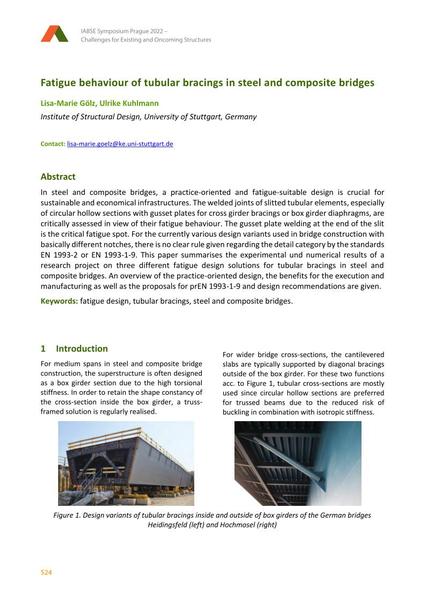Fatigue behaviour of tubular bracings in steel and composite bridges

|
|
|||||||||||
Détails bibliographiques
| Auteur(s): |
Lisa-Marie Gölz
(Institute of Structural Design, University of Stuttgart, Germany)
Ulrike Kuhlmann (Institute of Structural Design, University of Stuttgart, Germany) |
||||
|---|---|---|---|---|---|
| Médium: | papier de conférence | ||||
| Langue(s): | anglais | ||||
| Conférence: | IABSE Symposium: Challenges for Existing and Oncoming Structures, Prague, Czech Republic, 25-27 May 2022 | ||||
| Publié dans: | IABSE Symposium Prague 2022 | ||||
|
|||||
| Page(s): | 524-531 | ||||
| Nombre total de pages (du PDF): | 8 | ||||
| DOI: | 10.2749/prague.2022.0524 | ||||
| Abstrait: |
In steel and composite bridges, a practice-oriented and fatigue-suitable design is crucial for sustainable and economical infrastructures. The welded joints of slitted tubular elements, especially of circular hollow sections with gusset plates for cross girder bracings or box girder diaphragms, are critically assessed in view of their fatigue behaviour. The gusset plate welding at the end of the slit is the critical fatigue spot. For the currently various design variants used in bridge construction with basically different notches, there is no clear rule given regarding the detail category by the standards EN 1993-2 or EN 1993-1-9. This paper summarises the experimental und numerical results of a research project on three different fatigue design solutions for tubular bracings in steel and composite bridges. An overview of the practice-oriented design, the benefits for the execution and manufacturing as well as the proposals for prEN 1993-1-9 and design recommendations are given. |
||||
| Copyright: | © 2022 International Association for Bridge and Structural Engineering (IABSE) | ||||
| License: | Cette oeuvre ne peut être utilisée sans la permission de l'auteur ou détenteur des droits. |
||||
